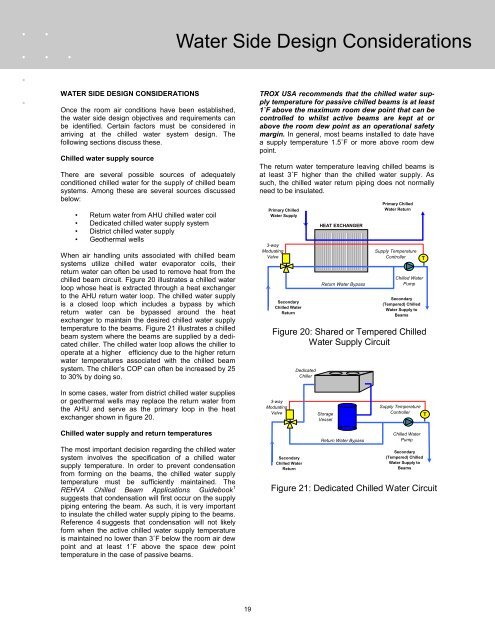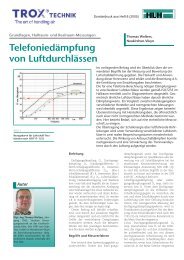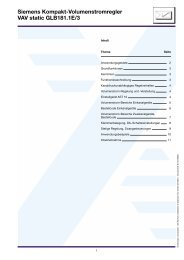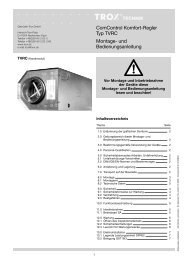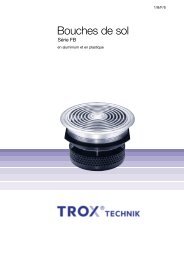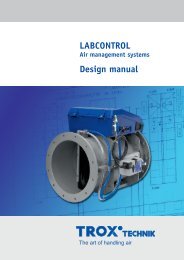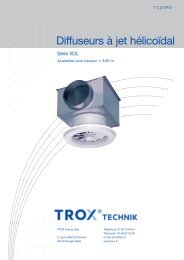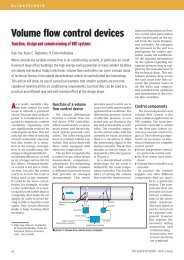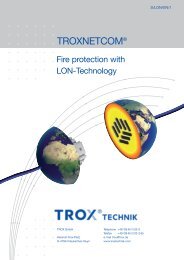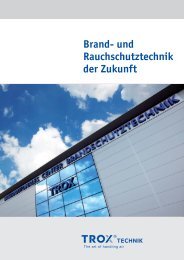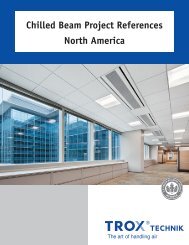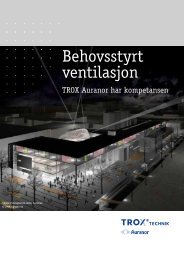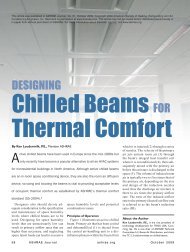You also want an ePaper? Increase the reach of your titles
YUMPU automatically turns print PDFs into web optimized ePapers that Google loves.
Water Side <strong>Design</strong> Considerations<br />
WATER SIDE DESIGN CONSIDERATIONS<br />
Once the room air conditions have been established,<br />
the water side design objectives and requirements can<br />
be identified. Certain factors must be considered in<br />
arriving at the chilled water system design. The<br />
following sections discuss these.<br />
<strong>Chilled</strong> water supply source<br />
There are several possible sources of adequately<br />
conditioned chilled water for the supply of chilled beam<br />
systems. Among these are several sources discussed<br />
below:<br />
• Return water from AHU chilled water coil<br />
• Dedicated chilled water supply system<br />
• District chilled water supply<br />
• Geothermal wells<br />
When air handling units associated with chilled beam<br />
systems utilize chilled water evaporator coils, their<br />
return water can often be used to remove heat from the<br />
chilled beam circuit. Figure 20 illustrates a chilled water<br />
loop whose heat is extracted through a heat exchanger<br />
to the AHU return water loop. The chilled water supply<br />
is a closed loop which includes a bypass by which<br />
return water can be bypassed around the heat<br />
exchanger to maintain the desired chilled water supply<br />
temperature to the beams. Figure 21 illustrates a chilled<br />
beam system where the beams are supplied by a dedicated<br />
chiller. The chilled water loop allows the chiller to<br />
operate at a higher efficiency due to the higher return<br />
water temperatures associated with the chilled beam<br />
system. The chiller‟s COP can often be increased by 25<br />
to 30% by doing so.<br />
<strong>TROX</strong> USA recommends that the chilled water supply<br />
temperature for passive chilled beams is at least<br />
1˚F above the maximum room dew point that can be<br />
controlled to whilst active beams are kept at or<br />
above the room dew point as an operational safety<br />
margin. In general, most beams installed to date have<br />
a supply temperature 1.5˚F or more above room dew<br />
point.<br />
The return water temperature leaving chilled beams is<br />
at least 3˚F higher than the chilled water supply. As<br />
such, the chilled water return piping does not normally<br />
need to be insulated.<br />
Primary <strong>Chilled</strong><br />
Water Supply<br />
3-way<br />
Moduating<br />
Valve<br />
Secondary<br />
<strong>Chilled</strong> Water<br />
Return<br />
HEAT EXCHANGER<br />
Return Water Bypass<br />
Primary <strong>Chilled</strong><br />
Water Return<br />
Supply Temperature<br />
Controller<br />
<strong>Chilled</strong> Water<br />
Pump<br />
Secondary<br />
(Tempered) <strong>Chilled</strong><br />
Water Supply to<br />
<strong>Beam</strong>s<br />
Figure 20: Shared or Tempered <strong>Chilled</strong><br />
Water Supply Circuit<br />
Dedicated<br />
Chiller<br />
T<br />
In some cases, water from district chilled water supplies<br />
or geothermal wells may replace the return water from<br />
the AHU and serve as the primary loop in the heat<br />
exchanger shown in figure 20.<br />
3-way<br />
Moduating<br />
Valve<br />
Storage<br />
Vessel<br />
Supply Temperature<br />
Controller<br />
T<br />
<strong>Chilled</strong> water supply and return temperatures<br />
The most important decision regarding the chilled water<br />
system involves the specification of a chilled water<br />
supply temperature. In order to prevent condensation<br />
from forming on the beams, the chilled water supply<br />
temperature must be sufficiently maintained. The<br />
REHVA <strong>Chilled</strong> <strong>Beam</strong> Applications <strong>Guide</strong>book 1<br />
suggests that condensation will first occur on the supply<br />
piping entering the beam. As such, it is very important<br />
to insulate the chilled water supply piping to the beams.<br />
Reference 4 suggests that condensation will not likely<br />
form when the active chilled water supply temperature<br />
is maintained no lower than 3˚F below the room air dew<br />
point and at least 1˚F above the space dew point<br />
temperature in the case of passive beams.<br />
Secondary<br />
<strong>Chilled</strong> Water<br />
Return<br />
Return Water Bypass<br />
<strong>Chilled</strong> Water<br />
Pump<br />
Secondary<br />
(Tempered) <strong>Chilled</strong><br />
Water Supply to<br />
<strong>Beam</strong>s<br />
Figure 21: Dedicated <strong>Chilled</strong> Water Circuit<br />
19


